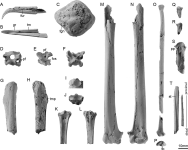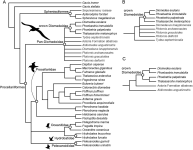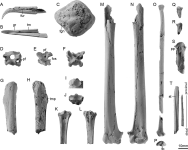Systematic palaeontology
Aves Linnaeus, 1758
Procellariiformes Fürbringer, 1888
Pan-Diomedeidae G.R. Gray, 1840
Plotornis Milne-Edwards 1874
Type Species. Plotornis delfortrii Milne-Edwards 1874
Included Species. Plotornis delfortrii,
Plotornis graculoides and
Plotornis archaeonautes (sp. nov.)
Revised Diagnosis. Plotornis is differentiated from all crown albatrosses by a more
slender beak and conspicuously shorter processus supracondylaris dorsalis which tapers distally (distal margin squared in crown albatrosses). Differs from
Tydea in having a longer processus supracondylaris dorsalis which is cranial-laterally directed (proximally deflected in
Tydea).Differs from
Diomedavus in more proximally located apex of crista deltopectoralis of the humerus, and in the absence of an ossified retinaculum extensorium of the tarsometatarsus. Differs from
Aldiomedes in wider beak.
Plotornis differs from poorly known taxa historically lumped in the genus
Diomedea as follows: from ‘
Diomedea’ thyridata and potentially also ‘
Diomedea’ tanakai in having a more slender beak tip (the wide beak tip in the latter is based on a tentatively referred specimen); from ‘
Diomedea’ tanakai in having a less medially flared rim of the cotyla medialis; from ‘
Diomedea’ californica based on much smaller size (overall size approximately two-thirds that of
D. californica based on proximal tarsometatarsus width); and from ‘
Diomedea’ milleri in having a larger plantar opening of the lateral foramen vasculare proximale.
Comments. Pan-Diomedeidae is used here as a name for the albatross total group, i.e. all taxa more closely related to Diomedeidae than to any of the other extant clades of Procellariiformes.
Plotornis archaeonautes sp. nov.
urn:lsid:zoobank.org:act:44CDC41D-5249-4D12-9FBA-3783C10F3C32
Holotype. OU 22690: partial skull, cervical vertebra, right humerus lacking proximal
end, shaft of left humerus, nearly complete left radius, proximal end of right and left ulna, proximal end of right carpometacarpus, shaft of left carpometacarpus.
Referred material. NMNZ S48291: proximal portion of right tarsometatarsus; NMNZ
S47315 proximal portion of left radius (Figure 2). The tarsometatarsus is in the range
expected for the species based on the proportions of Plotornis delfortrii. The referred
radius does not differ meaningfully from the holotype but is ∼20% larger. This is within the range of size variation observed in extant albatross species, though more complete material may eventually reveal the presence of multiple albatross species in the fauna.
Etymology. From the Greek ἀρχαῖος (ancient) + ναύτης (mariner). The name reflects
the ancient age and the wide oceanic range of
Plotornis albatrosses, and makes allusion to the fabled albatross of Samuel Taylor Coleridge’s The Rime of the Ancient Mariner.
Type Locality and Horizon. Earliest Miocene (Aquitanian) Mount Harris Formation,
Hakataramea Quarry, South Canterbury, New Zealand (New Zealand Fossil Record
Number I40/f442).
Measurements. Humerus distal width 19.5 mm (Plotornis delfortrii: ∼18.0 mm;
Plotornis graculoides: 19.0 mm), tarsometatarsus proximal width 14.0 mm as preserved, estimated 15.0 mm when complete (
Plotornis delfortrii: 12.6 mm;
Plotornis graculoides: ∼14.5 mm).
Diagnosis. Plotornis archaeonautes differs from
Plotornis delfortrii in the more proximodistally elongated tuberculum supracondylare ventrale, shallower fossa m. brachialis, and less ventrally deflected proximal tip of the condylus dorsalis, and differs from
Plotornis graculoides in having a more weakly developed tubercle at the distal end of the crista deltopectoralis, a less widened proximal end of the tarsometatarsus (relative to shaft width), and a more distal origin of the crista plantaris lateralis of the tarsometatarsus.
Comments. Due to the incomplete nature of previously described material, our referral of the new fossil to
Plotornis relies primarily on similarities in the distal end of the humerus. While it is possible that future discoveries will reveal differences requiring the erection of a new genus, we opt for a taxonomically conservative approach.
Fred
Figure 1. Holotype (OU 22690: A-I, M-P, S-T) and referred specimens (NMNZ S48291: J-L, NMNZ S47315: Q-R) of
Plotornis archaeonautes. Beak tip in A, lateral and B, ventral views, C, skull roof in dorsal view, cervical vertebra 12 in D, cranial, E, lateral and F, dorsal views, fragment of left humerus in G, caudal and H, cranial views, I, proximal end of right ulna in proximal view, referred right tarsometatarsus in J, proximal, K, dorsal and L, plantar views, right humerus in M, caudal and N, cranial views, left radius in O, ventral (rotated slightly) and P, distal views, referred left radius in Q, ventral and R, dorsal views, S, proximal portion of right carpometacarpus in ventral view, T, shaft of left carpometacarpus in dorsal view. Abbreviations: fgn: fossa glandulae nasalis; fos: fossa housing subdivided pneumatic foramen; fur: furrow on lateral face of beak, gr: groove formed where furrow meets tomial margin; pf: pneumatic foramen; pp: processus pisiformis; st: sulcus tendineus; tb: tubercle at distal end of radius; tm: tomial margin; tmp: tubercle for the insertion of m. pectoralis.
 Figure 2.
Figure 2. Results of phylogenetic analysis. A, Strict consensus of 38 MPTs of 416 steps from analysis including all taxa. B, Strict consensus of 4 MPTS of 416 steps from analysis excluding
Aldiomedes and the Astoria Formation albatross. C, 14 MPTS of 414 steps from analysis excluding all fossil albatrosses except
Aldiomedes and the Astoria Formation albatross. Only Pan-Diomedeidae are shown in B and C. Silhouette art from Phylopic, created by Kimberly Haddrell (Diomedeidae), Alexandre Vong (Procellariidae and Oceanitidae) and Juan Carlos Jerí (Pelecanoididae).








